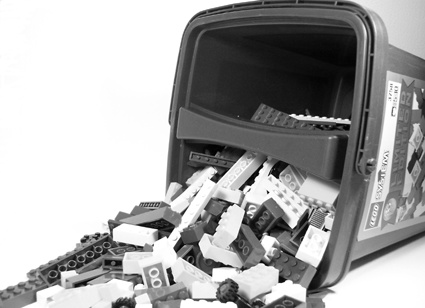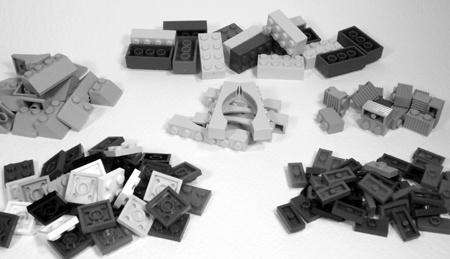When most people think of storing a bunch of LEGO bricks, they think of that plastic tub or maybe that cardboard box a lot of kids have. It’s chock-full of assorted parts from a number of different sets and gets dumped on the living room floor when friends or cousins come to visit. It offers ease of use, but it does not really allow any sorting of bricks into meaningful batches.
That box is probably suitable if you have a few thousand LEGO pieces or less. But if you have more than 5,000 or 6,000 elements, you might find that it is getting not only heavy but also crowded. Once you have more than 10,000 bricks, it’s time to do some sorting. Figure 12-1 shows that it only takes a few dozen pieces to make a pile that needs sorting.
At some point in your building career, you will need to begin the process of sorting your pieces into smaller containers. For some people, this is the least enjoyable part of the LEGO hobby. For others, this process is a pleasant change of pace from building or planning models. No matter what your take on the subject, you must eventually decide how to sort and store your collection.
First let’s separate this topic into its three main components:
- Sorting bricks
The system or method by which you separate bricks into piles/categories.
- Storing bricks
The physical boxes, containers, and drawers that sorted bricks go into.
- Setting up a build area
The type and quantities of bricks you keep readily available and the area you set aside for working in.
Although sorted bricks are often stored in the manner in which they’ve been divided up, there is a distinct difference between the system you use to sort and the containers into which you place your sorted pieces. Think of the process of sorting as being similar to that you’d perform on a list of phone numbers and email addresses for your family and friends. You might sort this list alphabetically, by the length of time you’ve known the person, by where they live, or by group (friends, family, coworkers, and so on). However you approach it, this is your method of sorting.
Once it’s organized, you might decide to store this information in a small book with lined paper and lettered tabs, you might type it onto one long sheet of paper so you can keep it in your wallet, or you might decide to use some computer software (like an email program) to store it electronically. Whatever you decide on is your system of storing.
In the next section, you will focus exclusively on sorting. You can, for the moment, assume that you’re just making piles of bricks on the floor or on a table, such as the small piles shown in Figure 12-2.
You will look at various ways to determine what goes into each pile. Later, I’ll talk about what kinds of containers you can use to store these piles.


